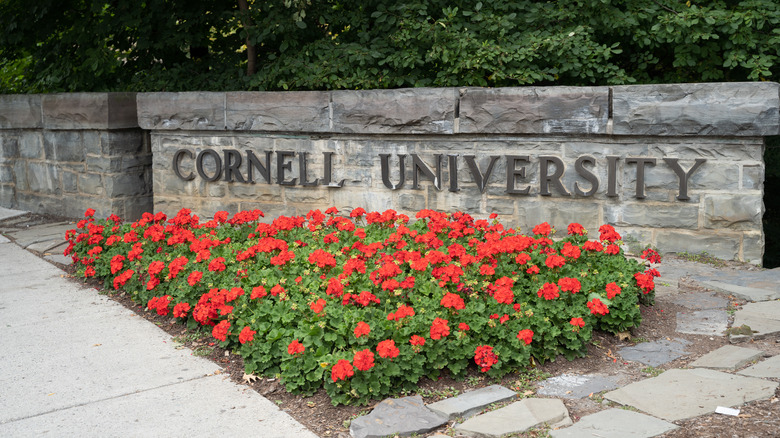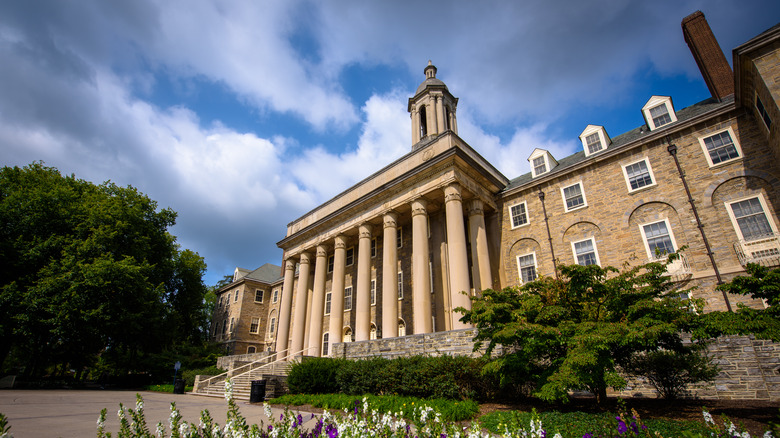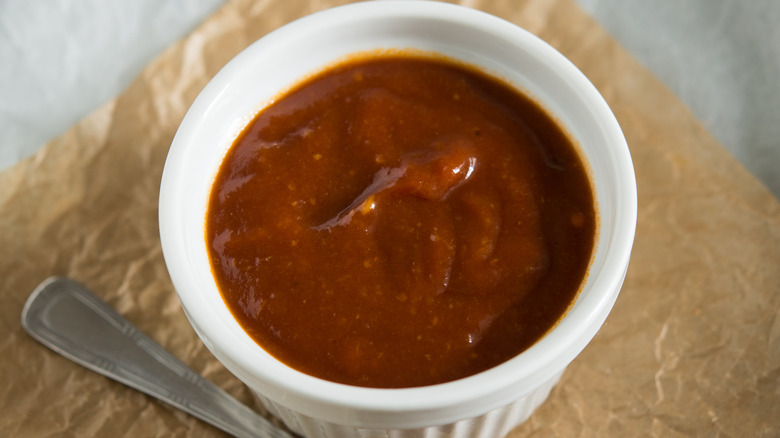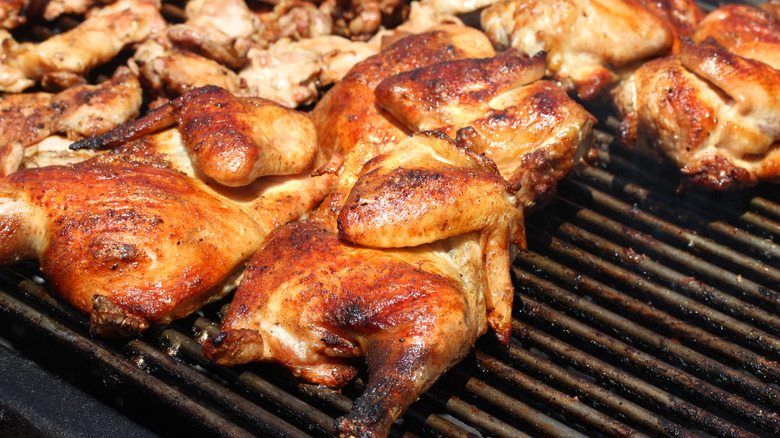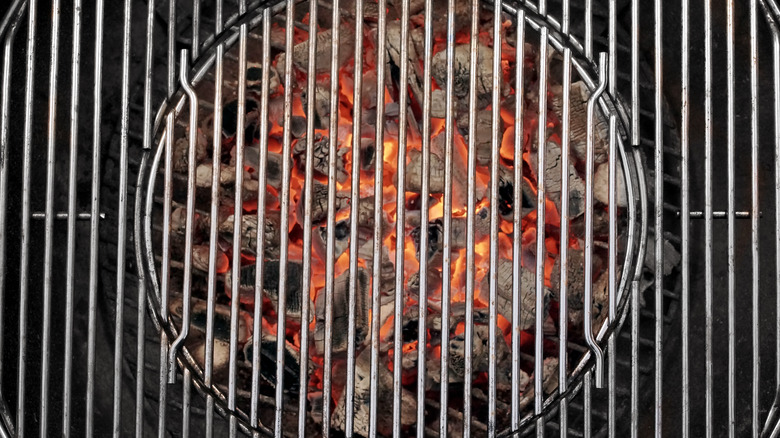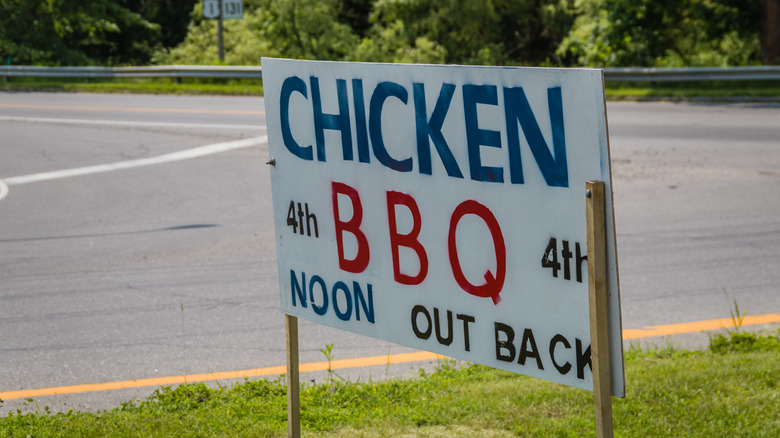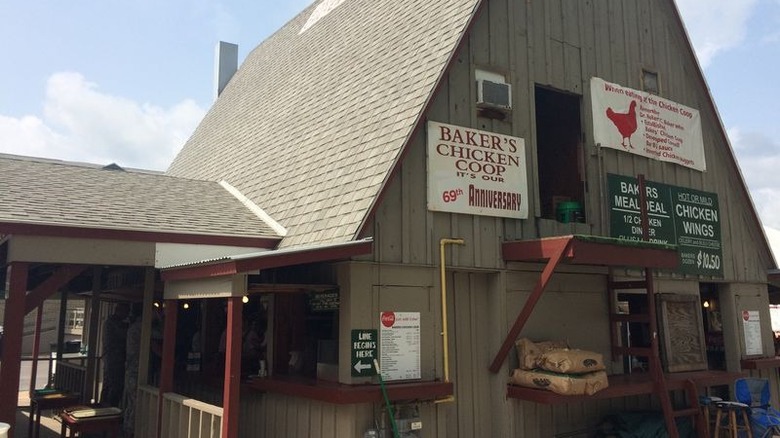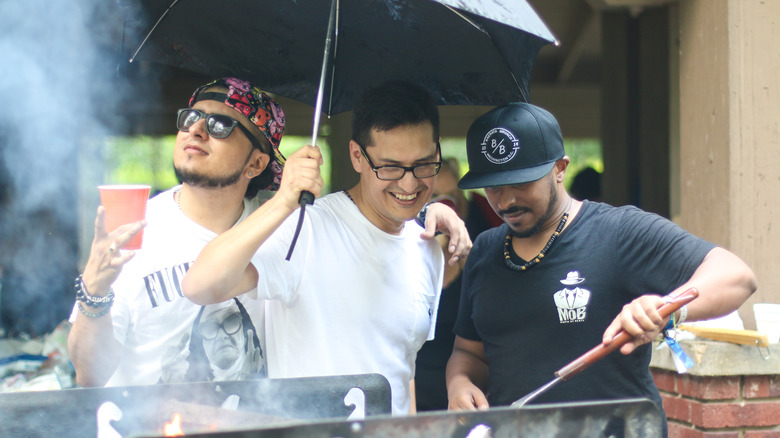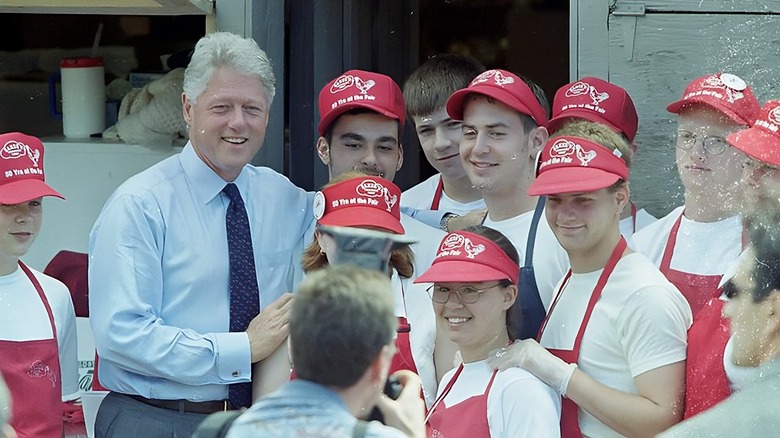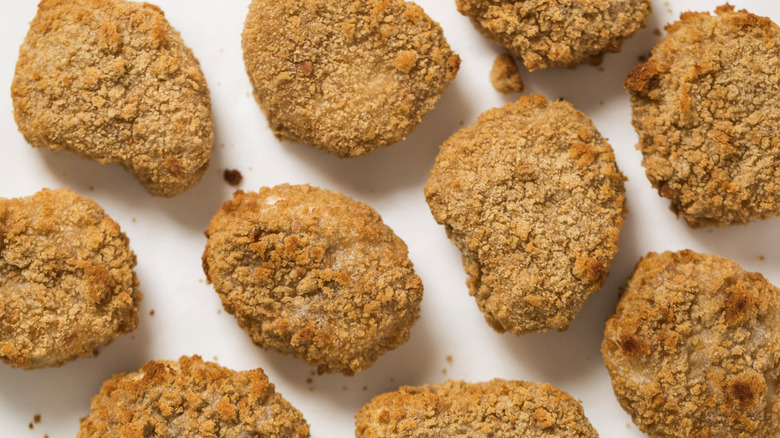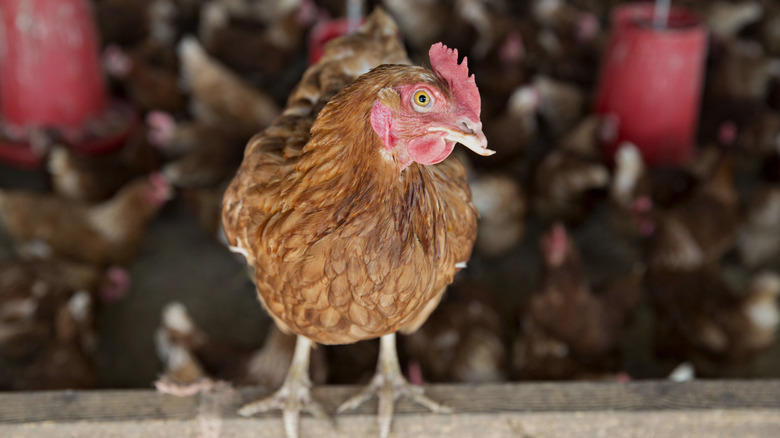Facts You Should Know About Cornell Chicken
There's a decent chance you've never heard the term "Cornell Chicken." Even some of the experts can't agree exactly how big a deal it is. When writing about it in 2019, the New York Department of Agriculture and Markets referred to it as a regional dish. Conversely, Ahwatukee Foothills News of Arizona has called it "one of the most famous chicken recipes in America." But even if this article is your first time seeing the dish's name, you may be familiar with the concept. The simple combination of chicken and barbecue sauce cooked on the grill is something few summer cookouts can go without. And Cornell Chicken — which is sometimes called State Fair Chicken for its ubiquity at such events — is where it all started.
The story of how Cornell Chicken came to be is even more fascinating than the food itself. You might be able to imply from the name that it has something to do with Cornell University. But how is an Ivy League school connected to barbecue chicken? And how did such a seemingly simple dish help completely change America's poultry industry, as the Cornell College of Agriculture and Life Sciences puts it? These facts about the history of Cornell Chicken will answer every question you have and then some regarding this influential American cuisine.
1. It was created by a professor
While some dishes are developed by several people or a whole group, we have one man to thank for Cornell Chicken. The late Dr. Robert C. Baker graduated from Cornell University in 1943 with a bachelor's degree in pomology, and in 1949, he joined the Department of Poultry Science as an assistant professor (via The Cornell Daily Sun). The same year, Baker got his master's degree from Penn State, and he later earned a doctorate in 1956 from Purdue University. (And if you've never heard of pomology, it as the study of fruit science and production.)
Dr. Baker spent 40 years working for Cornell University before retiring in 1989. Along the way, he founded the school's Department of Food Science and the Institute of Food Science in Marketing, serving as the institute's first director. Baker also worked for the National Poultry Improvement Plan. In short, Robert Baker was both really smart and a food guy. The latter isn't surprising when you consider he was raised on a fruit farm. It's also not surprising the barbecue chicken dish he created ultimately bore the name of the place he studied and taught at for more than four decades.
2. Cornell Chicken was actually developed at Penn State
Here's the kicker about the Cornell Chicken name, though — Robert Baker didn't come up with it at Cornell. The exact story of its origins varies, but according to The Morning Call, it goes something like this: In 1946, Penn State hosted a dinner honoring Pennsylvania's then-governor Edward Martin. Baker, who was both working for Penn State as an assistant professor and getting his master's degree from them in marketing, was tasked with coming up with a unique food for the event. The resulting recipe is what would later be known as Cornell Chicken.
So, why is it not called Penn State Chicken? Because Baker didn't start publicizing his new recipe until he started working at Cornell University. When Baker was hired in 1949, he was given a new task: help the New York state poultry industry sell more chickens (via The Cornell Daily Sun). One year later, his barbecue chicken recipe and cooking method were published in a bulletin by the Cornell Cooperative Extension (via Edible Finger Lakes).
The timing was seemingly perfect. The Morning Call notes the popularity of outdoor cooking rose rapidly following World War II, and a barbecue chicken recipe was a great fit. Baker's students furthered the spread of the new-fangled chicken to their home states and countries, and it was eventually bestowed with the Cornell moniker.
3. It's all about the sauce
Anyone can make the original Cornell Chicken recipe, and no matter where you get your recipe from, the first component is always the sauce. It consists of six ingredients you can find at most grocery stores: vegetable/cooking oil, cider vinegar, salt, pepper, poultry seasoning, and an egg to help everything stick to the meat. This base recipe is enough for 10 half-chickens.
From there, you have some leeway over how to prepare and apply the sauce. Reenie Baker-Sandsted, one of Robert Baker's daughters, say the original recipe calls for the sauce to be basted onto the chicken as it cooks and that this method helps the chicken skin absorb it. However, Food Network notes you can marinate the chicken in the sauce beforehand. Some people add their own touches, with Cook's Country mixing in sage, thyme, and mustard while replacing the vegetable oil with olive oil.
Regardless, the result is juicy chicken with a tangy seasoned flavor. The recipe is also notable for having a vinegar base rather than tomatoes like many modern barbecue sauce recipes. In fact, back in 1975, Dr. Baker told The New York Times his only rule about barbecue sauce was to never use a tomato base. In his words, "It's a sure way to burn the chicken." Remember this the next time you slather on a sauce that lists tomato paste or tomato purée as an ingredient.
4. The meat and cooking are important, too
When some people have a chicken cookout, they'll throw just about any piece of the bird on the grill — the breast, thighs, wings — you name it. However, per the Cornell Cooperative Extension of Warren County, a true Cornell Chicken recipe calls for using "broiler halves," with a broiler being a chicken raised solely for its meat (via National Agricultural Statistics Service). When speaking to The New York Times decades ago, Robert Baker added that a one-pound broiler half was a perfect size, and you should also try to find chicken with lots of yellow color and yellow fat.
As for how to cook Cornell Chicken, the Illinois Times says to grill it over a medium-low fire, with the Cornell Cooperative Extension adding that you should wait to put it on the grill until the flame is gone. Turn the chicken every 5 to 10 minutes and baste it with the sauce after each turn — a little at first, then more and more as you get later in the process. It should take about an hour until the chicken is thoroughly cooked and the skin is golden brown. Also, start with the chicken skin side up. This will reduce the chances of it burning or charring.
5. You can build the perfect fireplace
If you want to cook Cornell Chicken exactly the way Dr. Robert Baker did, you can. That's because he did more than just explain how the chicken should be cooked. In the Cornell Cooperative Extension Information Bulletin 862, "Barbecued Chicken and Other Meats," Baker laid out the materials and methods for building a fire pit to cook his now-famous chicken for large groups — complete with pictures. According to the creator himself, brick, stone, and cinder blocks are the best materials for permanent pits, while collapsible metal pits are acceptable for portable grilling. He said not to use concrete blocks since these are damaged by heat.
That's not all, though. The bulletin includes construction recommendations for turning racks that let you flip multiple chicken pieces at once. He also has suggested seating arrangements for serving a large group and even what to serve for sides and desserts. It's basically a barbecue chicken bible that is still useful today. In 1975, The New York Times reported that more than 300,000 copies had been sold. And according to Edible Finger Lakes, as of 2015, the bulletin was one of the 20 most-downloaded items from the Cornell University digital library. One final note: Information Bulletin 862 recommends using charcoal briquets (sic) since they burn long enough to cook the chicken. In 1998, Dr. Baker also told The Morning Call that chicken grilled over charcoal simply tastes better than if it's grilled over gas.
6. The cooking method is scientifically proven
As we've mentioned, Robert Baker wasn't just passionate about food — he was trained in it. After all, as pointed out by Slate, he had an advanced degree in food science and ran a poultry technology lab when he wasn't teaching. So, of course the cooking methods he recommends are based in science. Baker even had a study published in the September 1972 issue of Poultry Science called, "The Effect of Rate of Cooking on the Quality of Barbecued Chicken."
In this study, Baker ran a series of trials involving barbecued broiler halves — not coincidentally, the same pieces of chicken listed in the official Cornell Chicken recipe. As summarized by The New York Times, Baker found the most important aspects of cooking chicken were that you turned it and basted it with the sauce often enough for it not to char or burn. If both these things are done, then the total cooking time and grilling temperature won't affect the overall quality. However, humidity, outdoor temperature, and other environmental conditions can impact the cooking. There's also an official test for determining whether a broiler half is ready: Try to pull the wing off. The chicken is done if the meat comes apart easily and you don't see any red color.
7. It's considered the start of barbecue chicken
Many people consider Cornell Chicken to be the first barbecued chicken. Although it may be impossible to verify whether this is true, the timeline does make sense. Institute of Agriculture and Change Policy notes the turning point in chicken becoming an American diet mainstay was the Chicken of Tomorrow contest to breed birds that produced more meat. A documentary about the contest was released in 1948 — one year before Baker became a Cornell University assistant professor and two years before he published his recipe.
Just as significantly, Baker ushered in the concept of the community chicken barbecue, with The Morning Call noting that he "did barbecues in every county in New York." While the Cornell Chicken recipe may not be known, the community barbecue certainly is. The barbeque chicken phenomenon has spread everywhere from fire department and church fundraisers to family reunions.
In 2022, Lansing, New York posthumously honored Dr. Baker with a plaque stating he "developed chicken barbecue sauce & safe cooking method to support fundraising by community groups in NYS" (via Tompkins Weekly). And, of course, as part of the dedication, a drive-through chicken barbecue was held to raise money for The Savage Club of Ithaca.
8. It was featured at the New York State Fair for decades
Robert Baker's '50 bulletin wasn't the first time New York was introduced to what would be known as Cornell Chicken. In 1949, the same year Baker was first hired by Cornell University, he and his wife Jacoba ran a food stand at the New York State Fair called "Baker's Chicken Coop" (via Syracuse.com). Serving chicken cooked using his new sauce, and frequently served with salt potatoes, the food stand became an instant hit. At its peak, Baker's Chicken Coop served a whopping 3,000 half-chickens per day.
The Lansing Star notes Robert and Jacoba Baker ran the state fair food stand every year until 1988, at which point the second generation of Bakers took over. Baker's Chicken Coop eventually became the longest-running food stand at the fair, and while they did make a few modern tweaks like offering quarter-chickens and wings, the recipe never changed. Sadly, its run would end after 71 years following the 2019 fair, with the family citing reasons that included COVID and the fair being increased to 18 days.
And interestingly, despite the food stand's popularity and his status as a minor food celebrity, Robert Baker was never interested in the spotlight. His daughter Reenie recalled that he largely stayed hidden at the back tending to the pits and making sure his chicken was cooked to perfection.
9. It's considered a staple of Upstate New York
Someone in Oregon or Arizona not having heard of Cornell Chicken is understandable. But you live in Upstate New York and have never heard of it, that would be borderline sacrilege. Meathead Goldwyn, author of Meathead: The Science of Great Barbecue and Grilling, lived in Ithaca for 18 years and puts it thusly: "Every fund-raising event, every fire department cookout, every little league barbecue, must serve this recipe or nobody would come" (via Meatheads AmazingRibs.com).
What's Cooking America agrees with this assessment, noting that it's served across the state of New York. Even Buffalo, which has its own famous dishes, such as buffalo wings, breaks out the original Cornell Chicken recipe for summer chicken barbecues (via Buffalo News). The chicken is served so often at firehouse fundraisers that many people know it as "Fireman's Chicken," rather than the official name.
The draw of Cornell Chicken is so powerful in the region that it has spread to politics — Ithaca Journal once wrote about the Trumansburg Rotary tradition of holding a Cornell Chicken barbecue every year on Election Day. And although it is ostensibly a regional dish, Atlas Obscura notes that publications such as Saveur and the Texas BBQ Posse have also given it rave reviews.
10. It got the thumbs up from a U.S. President
More than just barbecue aficionados, fair-goers, and community gatherings have experienced the deliciousness of Cornell Chicken. This meal has also gotten approval from the highest dignitaries in the land. In 1999, President Bill Clinton, along with his wife Hillary and daughter Chelsea, paid a visit to the New York State Fair. And as NPR recalls, they had one thing in mind: enjoying some of Robert Baker's barbecued chicken. As the story goes, Baker's daughter Reenie gave the first family a basket of apples when they arrived. President Clinton replied with a smile, "Those apples look good, but where's the chicken?"
Granted, it wasn't an impromptu visit. Reenie had been a guest at one of Hillary Clinton's events earlier in the summer and invited her to visit the fair. One thing led to another, and eventually the entire Clinton clan was along for the ride — and per Hillary's request, Reenie didn't even tell her family they were coming. President Clinton eventually got his chicken, with Baker's Chicken Coop serving the family eight Cornell Chicken breasts with unsweetened iced tea to wash it down. As Clinton departed the food stand to continue checking out the fair, he give Robert Baker a thumbs-up of approval. As the New York State Department of Agriculture and Markets wrote later on, "Even the leader of the free world knows where great barbecued chicken can be found."
11. The founder invented the chicken nugget
Despite so many people singing the praises of Cornell Chicken, Robert Baker is seldom given his due for another far more popular cuisine: the chicken nugget. Slate explains that 17 years before McDonald's first rolled out Chicken McNuggets, Baker introduced a precursor. Known then as "chicken sticks," Baker and student Joseph Marshall figured out both how to keep ground chicken together and how to make the batter stick to it after freezing.
Baker only sold the prototype chicken nugget in local supermarkets and admitted they weren't very popular at the time (via Cornell Chronicle). More significantly, Marketplace notes that, like with much of his other research, Baker sent the information for free to hundreds of companies. McDonald's officially denies that they used Baker's process and claims to have come up with chicken nuggets themselves. But The Cornell Daily Sun flat-out says that McDonald's used Baker's methods. Nowadays, the chicken nugget is found across America, with Statista reporting it is the most commonly eaten form of frozen fried chicken as of 2020. Baker never saw a penny of those sales — and he seemed to be fine with that. As another former student Robert Gravani told Slate, "He literally gave ideas away, and other people patented them."
12. He's also in the American Poultry Hall of Fame
You may not have even realized there's a Hall of Fame for poultry, but there is, and Cornell Chicken architect Robert Baker was inducted into the Poultry Hall of Fame in 2004, two years before his death. Run by the American Poultry Historical Society, the Hall of Fame is for U.S. and Canadian individuals who have had a meaningful impact on the North American poultry industry. It's an exclusive club, too. The Hall of Fame was founded in 1953, and only 103 members have been admitted in the first 69 years.
Cornell Chicken and chicken nuggets alone might have been enough to get Baker into the Hall of Fame, but it's not an exaggeration to say the man was a poultry savant. Slate credits him with concocting more than 50 new poultry-based products, including chicken-based hot dogs, meatballs, and cold cuts. His Hall of Fame bio adds that Baker was also responsible for frozen French toast. And the piece de resistance may have come in 1980 when Baker developed a new and improved method for shipping frozen chicken — a method quickly adopted by Frank Perdue, the founder of Perdue Foods (via Cornell Chronicle). It's no wonder that, according to the Carolina News & Reporter, Robert Baker was known as the "George Washington Carver of chicken." He is an undisputed poultry pioneer, and Cornell Chicken is just one of many things we can thank him for.

